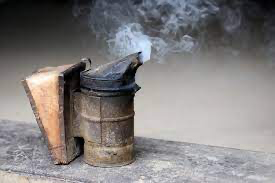My 2022 plan is to have three total hives: one hive is a Long Langstroth (following the plans linked below), and two traditional Langstroth hive kits from the Amazon May Bee store. I also purchased two additional boxes from Royal Alaskan Honey along with spring set-up items (frame feeders, supplements, etc). When the May Bee kits arrived, they came with two boxes of “bonus” essentials items, along with some minimal protective clothing (photo above). The purpose of protective clothing is to avoid bee stings; the clothing does not guarantee protection, but wearing it decreases your chances of being stung.
Word of caution: Although my family has been stung by many different insects, we didn’t know if any of us were allergic to honey bee stings. To be on the safe side, we did blood tests at our physician’s office to test for allergies. We found that none of us are allergic, so I will not need to keep an EpiPen on hand. I wonder how many beekeepers keep EpiPens on-hand though?
Honey Bee Stings 101
According to the USDA Agricultural Research Service: “When a honey bee stings, it loses its venom sac and stinger. This means the honey bee dies after it stings, but the stinger may continue to inject venom for up to a minute or until the stinger is removed.” This site advises that if you can see stingers, remove them by scraping them out with a credit card, knife or fingernail. Do not pull them out with tweezers or fingers because you will squeeze more venom into the wound.

Protection from Honey Bee Stings: Full-Body Suit
I always think of beekeepers wearing white fluffy looking suits (above), which is what you will see me wearing. Since I am new at this, and not yet comfortable with the bees (or the stings), I will be in head-to-toe protective clothing. I will wear an entire suit, including gloves, when inspecting the hives, which involves making sure the hive is healthy, looking for the queen, finding brood, larva, pollen, and honey stores.
Bee Smoker

I used to wonder why beekeepers used smokers, as it seems like such an odd practice but humans figured out that smoke calms bees during wildfires, and they ran with the idea when collecting honey. Moses Quinby created what we currently use: smokers / smoke pots with bellows. So what happens when you use a smoker? The smoke calms the bees by interrupting the pheromones (scents) that the bees produce when there is a threat to their hives. The small bit of smoke masks the pheromones so the bees stay calmer and the beekeeper can get into the hive to inspect, treat, feed, collect, etc.
Hive Tool

Hive tools are used to pry open and scrape the boxes. Most have a tapered flat end for prying and removing frames, and a curved end for scraping. These are similar to tools found at a Big Box Store, but I have not compared them to see how, or if, they are much different. In every single video I have watched, the hive tool is the number one item every beekeeper uses, even if they use nothing else listed above (including protective gear).
Beekeeping brush

What is a bee brush? It is similar to a drafting brush, but instead of wiping away eraser shavings, you use it to wipe the bees off the frame. It is used for hive inspections and anytime you need the bees off the comb. Bees have “sticky” feet, so sometimes they cling to things quite well and a bee bush is useful to remove them while avoiding stings. In all the hours of beekeeping videos I have watched, I cannot recall any beekeepers using bee brushes. Reviews on brush use are mixed, most indicating that bees will die when using the brush. It seems that there are a few specific techniques one must learn in order to avoid crushing the bees when on the comb, as well as not damaging the comb. What I have mostly observed: beekeepers use smoke and blow on the part of the hive they are inspecting – which moves the bees away from the spot you want to get into.
Further Reading
There are a lot of additional tools that can be used but are not required. I found excellent beekeeping websites at Mann Lake and Dadant. These two locations seemed to be the most useful for finding information about supplies, which I used to create a list and then purchased from local sellers. Some of the Alaskan bee package sellers also sell beekeeping supplies; examples in Southcentral Alaska include: Royal Alaskan Honey, Alaska Wildflower Honey, and a few others as well. I have also noticed kits and gear on Facebook Marketplace and Craigslist. As always, I advocate buying local as it feels great to support the local beekeepers, plus you get to meet like-minded individuals and possibly create connections and/or find a mentor!
My next post will be about putting your bees into your hives.
About Jamie Lang
Twitter •


